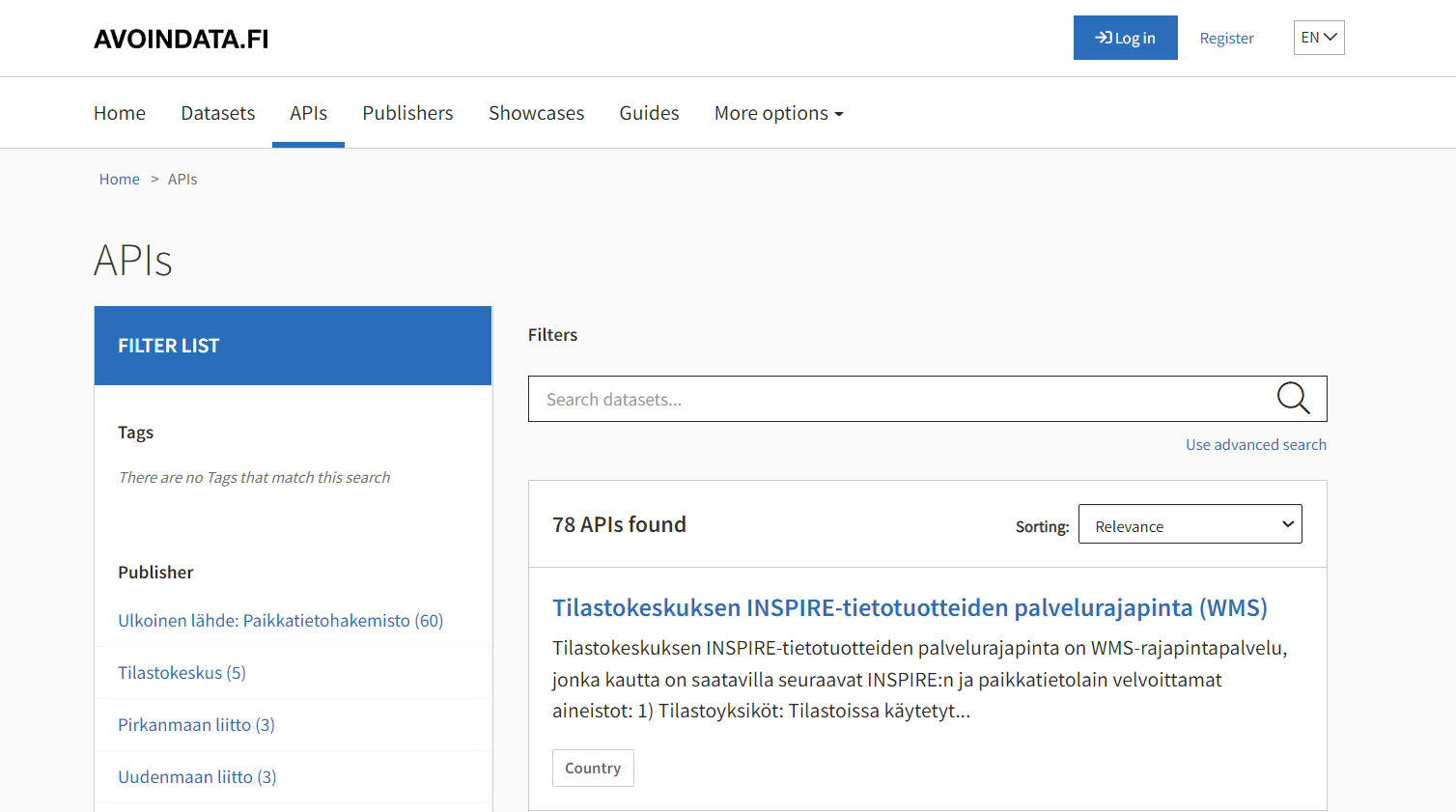On 20th of October 2022, we are publishing new features that will improve the way APIs are shown and handled on opendata.fi. APIs will have their own page and metadata model. Thus far all the open data in our service has been shown as datasets regardless of the format.

Going forward, it will be much easier to search and browse APIs added to our service. The metadata of the APIs will be more accurate as APIs will be described a bit differently compared to datasets.
Check out the new API page and please tell us what you thought about it and how it should be developed.
We are preparing for the implementation of Open Data Directive and increasing demand for APIs
Dynamic data that updates frequently and constantly changes is getting more and more common in our society. Many applications that use open data are also based on constantly updating data. For example, Sporat.fi application visualises Helsinki's trams on a map where the tram’s location changes almost every second. It is often not even possible to share such continuously changing data as a file. Files would need to be constantly updated or versioned which would make managing data impossible.
A better way to share this kind of data is through APIs (Application Programming Interface). The field of open data is moving towards utilising APIs even more too. Opendata.fi wants to respond to the growing demand and improve the findability of APIs in our service. When APIs are described in a similar way and found from one place it makes using open data provided through APIs easier.
We are also preparing for the changes brought by the implementation of the Open Data Directive and High Value Datasets. In the Open Data Directive published in 2019, APIs were highlighted as a way to share open data (Article 5 of the directive). High Value Datasets should be available mostly through APIs as well, so there will be a need for a service to which APIs can be added.
DCAT-AP metadata model extended to cover APIs
The DCAT-AP standard defines how the data added to different European open data portals should be described, meaning what kind of metadata is required for the data. It is important that the data is described in a unified way because all the open data from the member countries can also be found from the European Commission's data portal data.europa.eu. Without a common way for describing the datasets gathering them all to a one place would not be possible.
The current metadata model, DCAT-AP, has been developed mainly for files and APIs have not been considered that much in its development. This is why we have created an extension for APIs to our DCAT-AP data model. On opendata.fi, this means that slightly different metadata is required of APIs compared to datasets. For example, we recommend providing information about API's access rights whereas with datasets such information would not be relevant. Relevant, high quality metadata helps data users to utilise open data provided through APIs.
New API page is currently in test use
The API page will be in test use for now, which means that not all the APIs on opendata.fi can be found there yet. Only the APIs from the Geonetwork Paikkatietohakemisto are currently displayed on the new page. We will start increasing the number of APIs when we are satisfied with the new features and have made sure that everything works.
If you want to search for APIs and datasets with one search, please use the advanced search. We are planning to implement a general website search soon that you can use for searching all data in our service.
We will continue to develop API features with agile development in the coming years. Our vision is that the use of APIs that provide open data is as easy and effortless as possible in Finland and Europe. This challenge is so complex that not everything can be planned in advance, but we will improve the functionalities little by little according to customer feedback.
Changes for data publishers and users
The biggest changes for data publishers:
- APIs are added to opendata.fi from a different page than datasets
- APIs are described in a slightly different way, which means that different metadata will be required of them compared to datasets
If your organisation has already published APIs on opendata.fi as datasets, we will contact the administrator of the dataset later and give instructions on how to add the interface to our service.
We will publish instructions for adding APIs later. We are always happy to help if you should have any problems with the new API features.
In the future, the data publisher is responsible for ensuring that APIs are added to the service as APIs and files as datasets.
The biggest changes for data users:
- The URLs of datasets may change if the data has previously been added to opendata.fi as a dataset and later converted into an API
- If you want to search for both APIs and datasets, please use our advanced search.
If you have any questions, please contact us using the contact form.